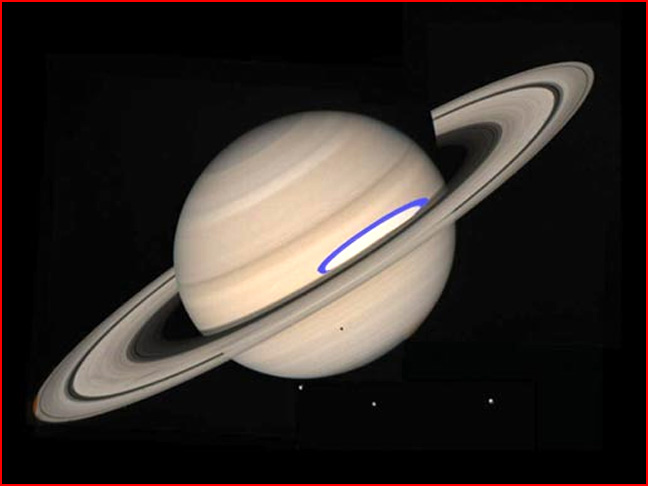|
|
||
 Credit: NASA/JPL |
||
|
pic of the day Links:
Society for
|
Aug 23, 2004 Many things about Saturn have changed in the 24 years since the two Voyager Spacecraft flew by. Saturn's magnetosphere has grown larger by more than a million miles. The dark spokes on Saturn's B ring have disappeared. The equatorial thunderstorm that raged continuously while both Voyagers passed has broken up and moved toward the poles. In November 1980 and August 1981, both Voyagers observed an intense storm near the equator (top photo) with high winds (1,100 miles per hour) and continuous lightning. This year, Cassini is observing less intense storms of short duration at mid-latitudes. Wind speeds are slower, too, topping out around 600 miles per hour. What causes the differences? Cassini researchers have proposed a possibility, based on meteorologists' theories of what causes storms on Earth -- differences in temperatures. In 1980/1981, Saturn was at equinox, the beginning of its 7-year-long spring in the northern hemisphere and fall in the southern hemisphere. The shadow of Saturn's rings fell almost exactly on Saturn's equator. The sunlit part of Saturn that received the most heat was adjacent to the part in the shadow of the rings that received much less heat. This juxtaposition of hot and cold parts generated intense turbulence, that is, storms and lightning. (One question left unasked is why hot and cold bands that encircle the planet's equator generated only one large but local storm.) The best part of this theory is that it is testable. Saturn's "year" is about 29 years long, which will bring the shadow of the rings back to the equator in 2008, about when the Cassini mission is scheduled to end. Cassini should be able to see if the intense equatorial storm returns. The above theory is based on the standard assumption that planets and stars are isolated bodies in space and that the only interactions between them arise from gravity, heat and light. The Electric Universe perspective sees a full spectrum of electromagnetic connections as well. So the Electric Universe looks to other phenomena to explain the changes on Saturn. The most likely candidate is that the storms on Saturn are Saturn's equivalent of sunspots. In 1980/1981, the Sun was at the peak of its 11-year sunspot cycle. Today the sunspot cycle is approaching minimum. If Saturn's "sunspots" are driven by the same galactic Birkeland currents that drive the Sun's spots, they will get stronger and closer to the equator as the sunspot cycle intensifies. Unfortunately, Cassini's 4-year mission will have to be extended to the next solar maximum in 2011 to test this theory. The solar cycle connection explains not only the changes in lightning patterns on Saturn, but also the expanded magnetosphere and the (now) missing spokes. The higher electrical stress throughout the solar system in 1980/1981 would have compressed Saturn's magnetosphere and created the dark spokes. (The spokes revolved to the tune of Saturn's magnetic field rather than to gravity's rules, suggesting they were electrical discharges across the rings. And each separate spoke began when Saturnian "dawn" reached the longitude associated with the long-lasting equatorial storm.) The lower stress of solar minimum allows the magnetosphere to relax, the spokes to fade, and the "storms" to migrate toward higher latitudes. |
|
|
Copyright 2004: thunderbolts.info |
||
